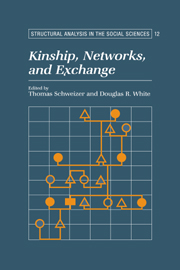Book contents
- Frontmatter
- Contents
- Preface
- List of contributors
- 1 Revitalizing the Study of Kinship and Exchange with Network Approaches
- I Representing Kinship Dynamics, Material Flow, and Economic Cooperation
- 2 The Grapevine Forest: Kinship, Status, and Wealth in a Mediterranean Community (Selo, Croatia)
- 3 Kinship, Property Transmission, and Stratification in Javanese Villages
- 4 Network Mediation of Exchange Structures: Ambilateral Sidedness and Property Flows in Pul Eliya (Sri Lanka)
- 5 Alliance, Exchange, and the Organization of Boat Corporations in Lamalera (E. Indonesia)
- II Individual Embeddedness and the Larger Structure of Kinship and Exchange Networks
- III Marriage, Exchange, and Alliance: Reconsidering Bridewealth and Dowry
- IV Emergence, Development, and Transformation of Kin-Based Exchange Systems
- Index
3 - Kinship, Property Transmission, and Stratification in Javanese Villages
Published online by Cambridge University Press: 05 November 2011
- Frontmatter
- Contents
- Preface
- List of contributors
- 1 Revitalizing the Study of Kinship and Exchange with Network Approaches
- I Representing Kinship Dynamics, Material Flow, and Economic Cooperation
- 2 The Grapevine Forest: Kinship, Status, and Wealth in a Mediterranean Community (Selo, Croatia)
- 3 Kinship, Property Transmission, and Stratification in Javanese Villages
- 4 Network Mediation of Exchange Structures: Ambilateral Sidedness and Property Flows in Pul Eliya (Sri Lanka)
- 5 Alliance, Exchange, and the Organization of Boat Corporations in Lamalera (E. Indonesia)
- II Individual Embeddedness and the Larger Structure of Kinship and Exchange Networks
- III Marriage, Exchange, and Alliance: Reconsidering Bridewealth and Dowry
- IV Emergence, Development, and Transformation of Kin-Based Exchange Systems
- Index
Summary
INTRODUCTION
Kinship is a basic institution in human societies, ordering social interaction, reproduction, and the flow of resources. Although there is some questioning of underlying conceptions and definitions (Schneider 1984), kinship continues to be a central focus of anthropological inquiry (Peletz 1995; Shimizu 1991). The goal of this chapter is to analyze and represent kinship structures in a precise and comprehensible way, focusing on rural Javanese communities and social strata. We combine cultural analysis of kinship principles (kinship as a cultural construction) with an analysis of differentiation in kinship networks. Specifically, we are interested in studying the linkage between kinship and property transmission in different social strata by means of rigorous methods that are capable of mapping, in concrete ways, the embeddedness of economy and society.
In achieving these goals, we want to be able to map actual networks of genealogical (descent and marriage) ties, but we find the standard genealogical chart (from Rivers 1910 onward) too crude a way of representing network structure. Genealogies, with symbols for distinct individuals, their (often multiple) marriage ties, and the relations between parents and offspring, are typically so cumbersome as to limit the number of actors, kinship ties, and property flows that can be brought into a comprehensive diagram. In any case they lack a simple visual gestalt. The standard genealogy also cannot be represented as a graph with points for individuals and different kinds of lines for relations between them. This is because one of the basic genealogical relations, that of parentage, is not between one individual and another, but between one individual and a pair of other individuals.
- Type
- Chapter
- Information
- Kinship, Networks, and Exchange , pp. 36 - 58Publisher: Cambridge University PressPrint publication year: 1998
- 3
- Cited by



